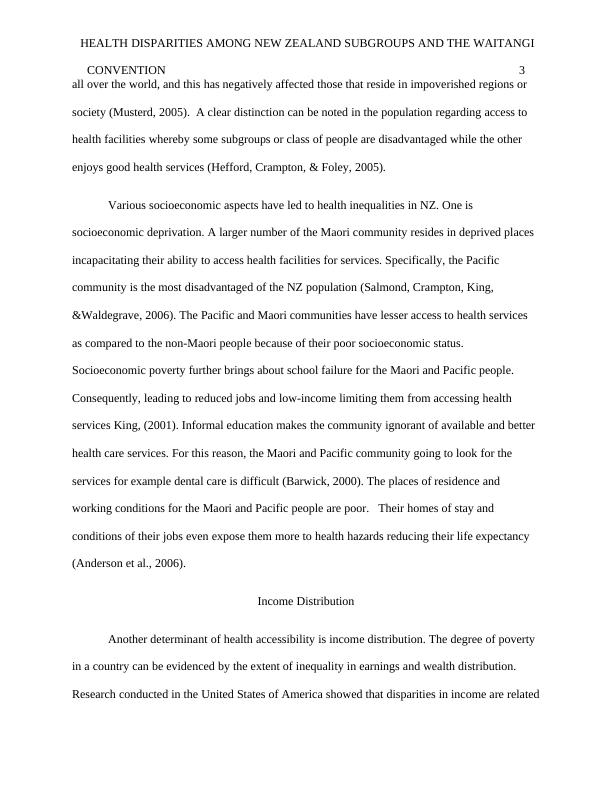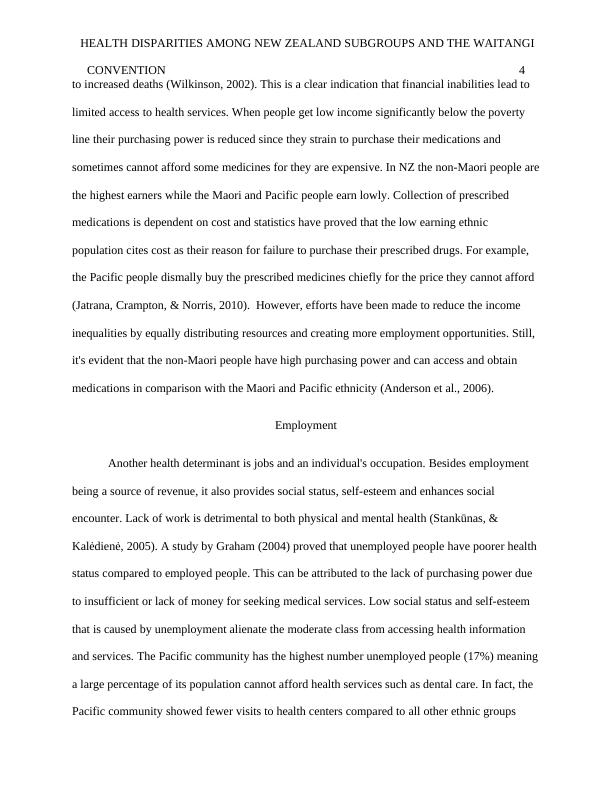Health Disparities Among New Zealand
Added on 2020-03-23
20 Pages5978 Words77 Views
Running head: HEALTH DISPARITIES AMONG NEW ZEALAND SUBGROUPS AND THEWAITANGI CONVENTION1Health Disparities among New Zealand Subgroups and the Waitangi ConventionName:Institution:Course:Date:

HEALTH DISPARITIES AMONG NEW ZEALAND SUBGROUPS AND THE WAITANGICONVENTION2Determinants of Health Inequalities among New Zealand SubgroupsIntroductionThere is a worldwide concern on health status disparities and the access to health facilities and services. Health differences amongst the population have been experienced in New Zealand (NZ) and have been prioritized by the government (King, 2000). One of the primary problems in NZ is the life expectancy gap between the Maori (indigenous people of New Zealand) and non-Maori (Pacific Islanders) which is nine and a half years (Ajwani et al., 2003). Available statistics have shown that health differences among the population subgroups are on the upward trend (Howden-Chapman, & Tobias, 2000), a reason for the NZ government setting it as a goal and even other governments of the world (Strategy, 2001). The bases for the health inequalities include age, socioeconomic status, ethnicity, gender, disabilities and geographical regions (Reid, & Robson, 2000).Socioeconomic FactorsAmong the health determinants, socioeconomic inequalities play a vital role in access to health services and in determining the health of a population, hence a point of significant concernby the government (Howden-Chapman, & Tobias, 2000). Health and premature death have been found to be primarily dependent on socioeconomic factors (Hallqvist et al., 2004). The influence of socioeconomic status in the fair share of health services goes beyond just financial capabilitiesand purchasing power. It has been noticed that social capital is key to the health of people and their community. Individuals with better connections to resources as a result of their wealth together with their community experience high life expectancy than those in poor neighborhoods(House, Landis, & Umberson, 2008). Classifying of various communities by their income occurs

HEALTH DISPARITIES AMONG NEW ZEALAND SUBGROUPS AND THE WAITANGICONVENTION3all over the world, and this has negatively affected those that reside in impoverished regions or society (Musterd, 2005). A clear distinction can be noted in the population regarding access to health facilities whereby some subgroups or class of people are disadvantaged while the other enjoys good health services (Hefford, Crampton, & Foley, 2005).Various socioeconomic aspects have led to health inequalities in NZ. One is socioeconomic deprivation. A larger number of the Maori community resides in deprived places incapacitating their ability to access health facilities for services. Specifically, the Pacific community is the most disadvantaged of the NZ population (Salmond, Crampton, King, &Waldegrave, 2006). The Pacific and Maori communities have lesser access to health services as compared to the non-Maori people because of their poor socioeconomic status. Socioeconomic poverty further brings about school failure for the Maori and Pacific people. Consequently, leading to reduced jobs and low-income limiting them from accessing health services King, (2001). Informal education makes the community ignorant of available and better health care services. For this reason, the Maori and Pacific community going to look for the services for example dental care is difficult (Barwick, 2000). The places of residence and working conditions for the Maori and Pacific people are poor. Their homes of stay and conditions of their jobs even expose them more to health hazards reducing their life expectancy (Anderson et al., 2006).Income DistributionAnother determinant of health accessibility is income distribution. The degree of poverty in a country can be evidenced by the extent of inequality in earnings and wealth distribution. Research conducted in the United States of America showed that disparities in income are related

HEALTH DISPARITIES AMONG NEW ZEALAND SUBGROUPS AND THE WAITANGICONVENTION4to increased deaths (Wilkinson, 2002). This is a clear indication that financial inabilities lead to limited access to health services. When people get low income significantly below the poverty line their purchasing power is reduced since they strain to purchase their medications and sometimes cannot afford some medicines for they are expensive. In NZ the non-Maori people arethe highest earners while the Maori and Pacific people earn lowly. Collection of prescribed medications is dependent on cost and statistics have proved that the low earning ethnic population cites cost as their reason for failure to purchase their prescribed drugs. For example, the Pacific people dismally buy the prescribed medicines chiefly for the price they cannot afford (Jatrana, Crampton, & Norris, 2010). However, efforts have been made to reduce the income inequalities by equally distributing resources and creating more employment opportunities. Still, it's evident that the non-Maori people have high purchasing power and can access and obtain medications in comparison with the Maori and Pacific ethnicity (Anderson et al., 2006).EmploymentAnother health determinant is jobs and an individual's occupation. Besides employment being a source of revenue, it also provides social status, self-esteem and enhances social encounter. Lack of work is detrimental to both physical and mental health (Stankūnas, & Kalėdienė, 2005). A study by Graham (2004) proved that unemployed people have poorer health status compared to employed people. This can be attributed to the lack of purchasing power due to insufficient or lack of money for seeking medical services. Low social status and self-esteem that is caused by unemployment alienate the moderate class from accessing health information and services. The Pacific community has the highest number unemployed people (17%) meaninga large percentage of its population cannot afford health services such as dental care. In fact, the Pacific community showed fewer visits to health centers compared to all other ethnic groups

End of preview
Want to access all the pages? Upload your documents or become a member.
Related Documents
Health Inequality in New Zealandlg...
|22
|4748
|251
He Korowai Oranga: Impact on Maori Health and Suicide Ratelg...
|10
|2341
|324
Primary Health Care Reviewslg...
|11
|3682
|20
Negative Experience With Respect to Healthcare and Educationlg...
|10
|3059
|22
Smoking Cessation Program for Schizophrenic Patients: Evidence-Based Nursing Researchlg...
|12
|3263
|161
Population Health: Ottawa Charter and Te Pae Mahutonga as a Framework for Health Promotion to Practical System Approachlg...
|12
|3181
|375
